by scott.gillum | Jul 20, 2012 | 2009, Sales
Original post date March 24, 2009
In August 1999, Selling Power magazine ran an article featuring our firm and the work we’ve done helping clients, like IBM, build new sales channels and increase sales productivity. A few months later, we received a call from the head of a division within NCR asking us to meet with them to see if we could help them with something similar.
The senior executive with whom we met said if we could help IBM we should be able to do this project for them. Excited about the prospect of helping them build a new channel, we agreed and they laid out the challenge:
- A well-known consulting firm had been previously engaged but had failed
- …which left only 41 working days to get the new sales channel up and running
- An internal NCR tele organization was competing for this…which, we would later learn, tried to sabotage the effort…and us
- And finally, we were entering the holiday season…good luck
After collecting the previous project work we quickly went to work on assessing what had gone wrong. It took us a while, but we finally discovered “IT”. Once found, this insight became the key to unlocking success.
Almost ten years later I’ve seen this scenario play out over and over in B2B companies. This is what we discovered.
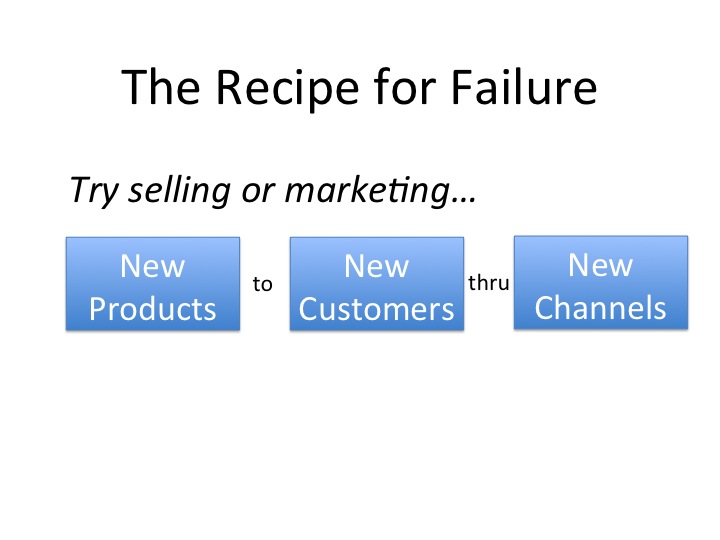
The secret recipe for failure
This simple equation is just as true today as it was a decade ago when we discovered it. Oh, you may find one or two exceptions but the majority of the time when we do post mordem on failed programs you find this equation is at the heart of the problem. When combined with a few related pieces, like a lack of time in the market and/or funding, the initiative is doomed. The degree of “newness” in these three areas will directly impact the likelihood of success or failure.
Sales Channels
- Why they fail – new sales channels fail because companies aim new channels at the wrong targets — new customers/markets. An investment in a new sales channel means that it is competing with existing channels for funding. If it does not hit expectations/goals quickly, it will be robbed of the necessary funding and/or resources needed to make it successful.
- How to improve the chances for success – The most successful way to build a new sale channel is to do exactly the opposite of what is described above. Shift coverage of existing customers or products to the new channel and use your existing channels to go after the “new.” Shift dormant or flat growth customers to the new channel to give it revenue immediately and free up your existing most knowledgeable, best trained sales folks to go after new opportunity.
Marketing Campaigns
- Why they fail – new marketing campaigns promoting new products aimed at new customers typically fail because of reasons listed above…they take too long to produce and/or aren’t given the time. Here’s another common problem, agencies will tell you the problem is the “creative” or “value prop”…maybe, but they also could telling you this because they make money on creative and production. “New” works with their business model.
- How to improve the chances for success – build less individual campaigns and invest more in one or two long term programs with many integrated tactics. Keep the programs in the market longer, closely monitor them and modify tactics based on performance. You don’t need a new campaign every month, you need a program that produces…and with tight budgets this will help you be cost effective/efficient. Years ago we did an assessment of campaign performance at IBM. We found that the highest performing campaigns had at least 7 integrated tactics and stayed in the market for at least 6 months. Use this as a starting point to design your campaigns and programs.
- New to New thru New – level set expectations and invest for the long haul. You will need time and commitment to make it successful. Companies have short-term horizons that are getting shorter every day. If you’re going to lead this effort get everyone to agree on what defines success and stick with your timeline.
- New Product/Service/Solution – try to leverage existing channels, customers or both to start…then migrate to new. This way you can learn if you have the right value prop, messaging, pricing, etc. We like to take existing reps, for example, and use them to help launch a new sales channel, like Tele. We like to use existing customers to test new products, etc.
We got the NCR teleaccount program up and running in 41 days. We transitioned existing field account managers to TeleAccount managers and built their territories around their customers. We then began to backfill them with new lower cost resources over time. You’ll be happy to now that the manager of the group that tried to sabotage the effort got fired.
The program hit our first year sales targets, reduced the expense to revenue ratio from 13% to 6% and grew sales productivity from $1.7M to $3.1M per rep. As a result, NCR then built a full-scale tele channel with close to 80 reps.
Then they killed it. It’s a long story but the bottom line was the company has a strong field sales tradition and culture. Mark Hurd, now CEO of HP, became the CEO of NCR, and decided to shut the channel down, redirecting the resources to the field.
Remember my comment about competing for resources. Mark’s an operations guy and a fan of face to face selling.
Culture runs deep, and can also kill channels and programs. Maybe I should update the “recipe” to include the forth “New”…new leadership.
by scott.gillum | Jul 19, 2012 | 2012
This post appears today on MediaPost’s Online Media Daily
Fancy (www.thefancy.com) is being totted as the next “Pinterest.” Now having passed a million members, its becoming the social media darling of the digital media. Add to that an all-star cast of investors, a defined business model based on commerce and you’ve months of hype to come.
What It Is
It combines the transaction capabilities of a daily deal site, like Groupon, with the visual imagery and organization of Pinterest. Like Pinterest, The Fancy lets users curate and organize images into list or boards. Unlike Pinterest, users can shop and with a click buy the product at on a third party site. It’s built with the intent of driving commerce. The Fancy, like daily deal sites, pushes out a daily email of specials to members.

Pinterest member commenting on a new flash drive
What’s Cool About It
Unlike other social media platforms (Pinterest, Twitter, Facebook, etc.) who first built a member/user base, Fancy is placing a bet on a defined revenue model out of the gate. And that bet is commerce, not advertising, at least not yet. As it is today, the Fancy will get 10 percent of each sale, paid for by merchants.

The Flash Drive, mentioned by the Pinterest member, on sale on The Fancy site.
But the real attention getter is the bet it’s placing on the power of social networks on purchase decision. The “holy grail” for social sites, is the ability to show a direct correlation between brand preference and buying that brand. Fancy, because of the integration of commerce and an ability to track conversion, has the potential to link intent with purchase. If successful, Fancy will attract merchants (and eventually advertisers) like a moth to a flame.
Three Reasons It May Not Work
Although I love the concept, there are several potential risks that could derail its success:
- Boxed in – The Fancy, unlike others, is trying to build a community around a business model. It’s a high risk gamble because, as other have seen (Linkedin and MySpace for example), business models often evolve based on users behaviors, which is often hard to predict. The other question – is Fancy entering a market that appears to be on a downward trend or could it be the next generation of daily deal sites?
- False Positives– It’s unclear how users will respond to unsolicited recommendations. The hope is that followers of users who had post products will self identify and make their intent known. The risk here is triggering “false positives,” in that, users my signal intent (“Fancy It”) without having any real motivation or desire to make a purchase decision. Yes, I want to buy the Ferrari you posted, but the reality is that’s not going to happen.
- Too Cool – one thing is certain about Fancy, members curate eye-catching products (carbon fiber beach paddles by Channel, for example). As Tim Peterson of Adweek points out, “Fancy is most useful to trendsetters and tastemakers, particularly those with disposable income.” But are the products being aggregated too cool for commerce? To scale the business will Fancy have to aim lower to drive transaction volumes?
Today, Pinterest’s conversion rate is now 3x that of Facebook (1.1% versus .35%). The big question is will that rate go higher with the integration of a commerce engine, like Fancy? If so, Pinners just might fancy a transaction on another platform…and merchants and advertisers will be right behind them.
by scott.gillum | Jul 19, 2012 | 2009, Marketing
My inbox is full of resumes of good marketers that I’ve been fortunate to come to know or work with over the years. Solid people, with great experience who are now having a challenging time finding new opportunities in this incredibly difficult economic environment. Many of these people could have had their pick of jobs as recently as last year. Given the situation, I thought I’d try to help by providing a viewpoint on what skills set, background and experience companies will be seeking once they start hiring again. I’ll use two data sources to make the case.
A few years ago, we teamed up with a professor (
John Josephs)at
Kellogg on a couple of research projects aimed at getting a better understand of what creates a high performance marketing organizations. Internally, we thought of it as the “head” and “body” studies because we first studied the marketing organization (
the body) and then the follow year CMO’s (
the head).
We surveyed not only CMO’s and marketers, but also CEO’s, about their views on what makes marketing effective. The research was then published by the
CMO Council. Here are a few things we discovered along the way.
CEO’s view on how to measure marketings performance
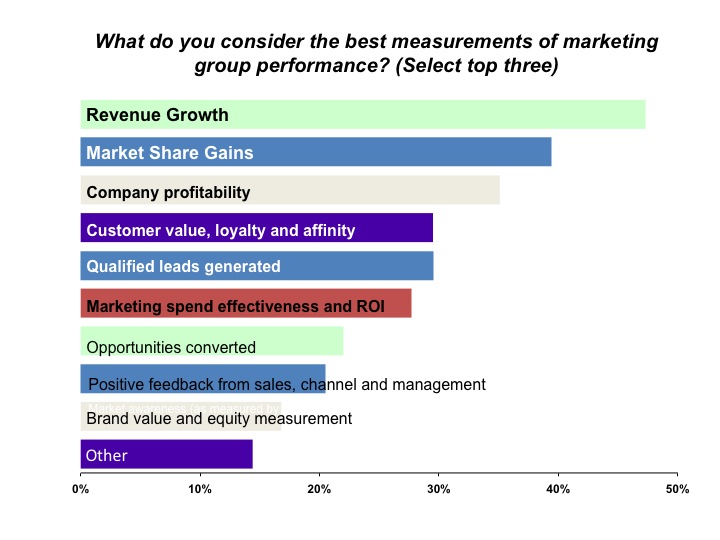
How CEO View Marketing Value and Performance
This information is a few years old now, but I can tell you that based on client work that the down turn has done nothing to change this, if anything, it has placed greater importance on the top 3-4 responses. Keep the top responses on these charts in mind as we move to the next section.
Last month, I was given access to a database of senior level marketers (SVP and up) to do some analysis for the organization that owns it. We looked at the background and experience of over 800 marketers with the following titles:
- 50% were CMO’s
- 32% EVP’s of Marketing
- 8% SVP’s of Marketing
- And interestingly enough 10% had CEO titles but had recently been the head of marketing
They came from large, medium and small companies including start ups:
- 25% – Large (over $500M)
- 32% – Medium ($100-$500M)
- 23% – Small ($50-$100M)
- 22% – Start up or under $50K
We were interested in assessing their area of expertise, experience and tenure.
Although executives with Product Management and Sales Enablement/Demand Gen experience represent only 27% of the total group, they represented a disproportionate amount of executives with the longest tenure. In fact, they were twice as likely (as a representative percentage) to be in the 2-5 years tenure category than those with Brand, Advertising and Corp Comm backgrounds. And they made up half of the individuals in the more than 5 year category.
Another interesting thing we picked up is that markerters in the NYC area were more likely to be new in role versus other regions (higher than average churn…probably attributed to a higher supply of talent).
Spencer Stuart has for many years reported CMO tenure rates (less than the life of a gold fish) but I’ve never seen them look at tenure by background…which makes a difference based on our assessment.
Finally, let’s look at Supply & Demand.
The Top 20 Advertisers in the US have been decimated. Think about…half of the Top 10 advertisers in 2007 were automobile manufactures. As a result, agencies have put hordes of people on the street.GDP in Q4 2008 is estimated to have declined by 6.2% from Q3 that declined by 0.5%. Revenues are down on average of 30-40% from the prior year in most firms (at least the ones we work with).
As a result, there are a slew of marketers with advertising, branding, and corporate comm backgrounds (73% of the database that we analyzed) in the market.
Let’s put it all together:
- CEO’s measure marketing effectiveness by revenue growth and market share
- CMO’s see the greatest need for new talent being driven by the integration of sales & marketing
- A large supply of “above the line” marketers exist in the marketplace
Conclusion– potentially high demand and a low supply of marketers who can drive revenue. The marketers that will be in the highest demand coming out of the recession will be the ones who have been aligned or have had direct responsibility for growing revenue. Marketers that can speak the language of sales. Unfortunately, it will be a slow process for folks with a Brand PR and Corp Comm or the Ex-Agency/Media guys.Marketers with backgrounds in Product Management/Marketing who have owned a P&L, folks with sales backgrounds and/or marketers who can show that they can drive revenue/growth will be in demand first.
The challenge for the other groups is that of supply. It’s not to say that good Brand and Agency folks won’t find positions it’s that it’s going to be hard. Expect that you will be competiting with many other qualified candidates and it may be difficult to differentiate yourself.
by scott.gillum | Jul 19, 2012 | 2011, Marketing
Original post date January 27, 2011
Owners of the MINI-Cooper have long been known to be one of the most fanatical and loyal of all call owners. They are likely to custom design their cars online, actively participate in local motoring clubs, and are in general, a passionate and faithful community.
A new project took me to the mid-west and I finally got a taste of the MINI-Cooper, courtesy of Budget rental cars. Initially, I was excited by the opportunity to find out what the buzz was about, but after getting in the little red car with white racing stripes, I quickly found myself totally discombobulated. It was like the car was designed by aliens, nothing was where it is should of been, and the layout, among other things still remain a mystery to me.
I couldn’t operate the windows the first half of the day, drove around with my blinker on for the other half. The radio settings were in the speedometer, and the tachometer was where the speedometer should have been. Even the gas gauge wasn’t a gauge at all, but rather a circle of lights.
The “Coop” had all the same instruments any other car has, but they were in different locations and/or in different forms. I’m still not convinced if the lay out of the dashboard is better, but one thing is true — I was fully engaged, I had to be. Even though I’ve been driving for almost 30 years I was a stranger in a strange land. Suddenly, driving was fun again.
It got me thinking about how we engage customers. There is a bunch of noise being made about customer engagement; the question for most of us is how to make it happen. Intuitively it makes sense, but from an execution standpoint, it’s still a bit of a mystery.
We have seen traditional response rates drop, and have begun experimenting with Social Media with little, to no, payoff. Although the true upside of customer engagement may still yet to be defined, a
Gallup research report points to it as a leading indicator for customer attrition. In some ways we’re searching for the Holy Grail, but maybe new isn’t the answer, maybe we have what we need.
As I sat at a stoplight and stared at the dashboard trying to make sense out of it, it hit me: It was if the MINI engineers intentional redesigned and/or rethought everything, most likely with the intent of keeping the Coop customer base happy and engaged with it’s quirkiness.
It showed me that you could create an engaging experience by leveraging what you already have. Granted, had I been on a tight schedule, I may not of enjoyed having to “get up to speed.” I was in a city that I had never visited and driving to see a client I’ve never met. I had my hands full directing the GPS, a stick shift, and a conference call.
I am not suggesting rearranging mission critical assets for key customers but what I am offering is this…maybe we need to rethink how customers engage and interact with our sales people, customer service reps, and the web. Like the engineers at MINI, we need apply our creative thinking skills to reordering our assets to provide customers with what they want, but delivered in new and intriguing ways.
At the end of the day the MINI still provides basic transportation – I got from point A to point B, but getting there was uncomfortable, scary, exciting and fun. Much of what we provide customers is basic “transportation,” and “mixing it up” can be scary, but it also may be the key to getting customers’ attention again.
by scott.gillum | Jul 19, 2012 | 2012, Sales
Large companies have long recognized the opportunity to address the needs of small business (26 million firms <99 FTE’s). Over the years, companies like IBM, American Express and Google have spent millions to try to understand the segment and convince business owners that they have the products and services they need.
Yet, they still struggle to capture of the opportunity in this segment, for a number of reasons. Despite their best efforts, they often fall back into their “big company” ways. They speak the wrong language, have a hard time creating compelling offers, and/or reinforce perception that they’re too big to serve small businesses.
Whether you’re a Fortune 500 company or an INC 500 firm, here are 10 key points to keep in mind when selling to the Small Business segment. All Insights below are taken from various research reports produced by the Executive Council on Small Business.
1. Don’t call them Small Businesses – despite this becoming common knowledge for many selling to this segment, companies still make the mistake. Despite the fact that 60% of small businesses, as defined by the U.S Census Bureau 2008, have less than 5 employees, don’t call them a small business.
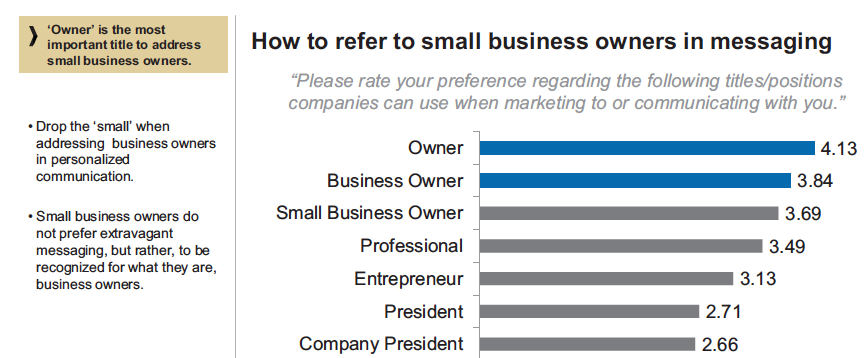
2. There are 2 different types of business owners – one type of owner is focused on growing their business, the other surprisingly, is not. Know the difference when targeting this segment. “Satisfaction owners” know also as “lifestyle owners” are older (>46) and more likely to have higher revenue businesses. They are in it because they love what they do and enjoy the work-life balance ownership present. “Growth” owners are more likely to be in retail, and more likely to have owned or own more than one business (serial entrepreneurs).
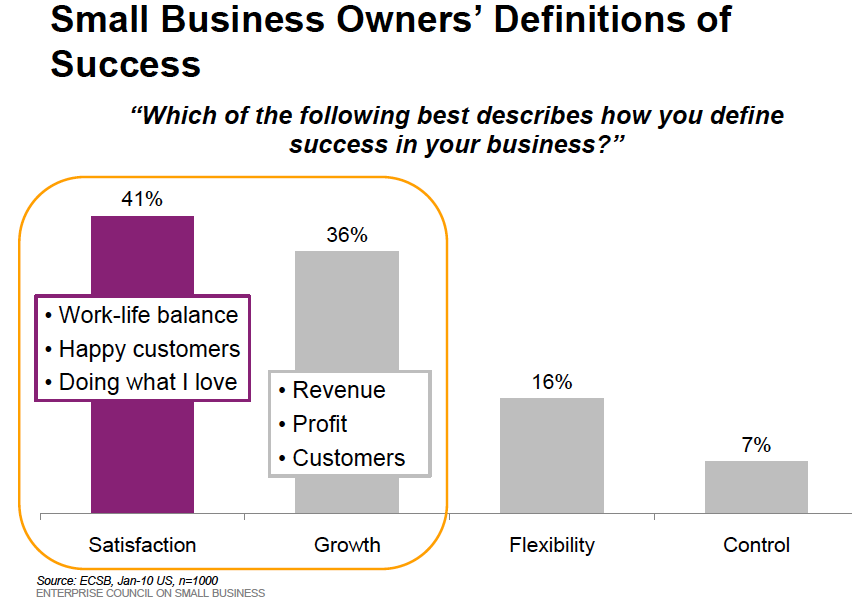
3. They are in the Service Business – for the most part small businesses are focused on providing services. 60% of small business are; professional services or other services (dry-cleaning, florist, cleaning service, etc.).
4. Speak THEIR language – As you might have already picked up, this will be a reoccurring theme in the post. 3X as many business owners find a sales person more trustworthy if he/she discusses savings in dollars rather than percentages. To be credible give them specific details, contact information and testimonials for other business owners (Top 3 Indicators of Credibility).
5. Small things are a BIG Deal – according to the research, a major purchase decision starts at $500. Cash flow is the lifeblood of small business don’t under estimate your need to prove value or ROI on what you would consider small transactions. If you’re talking about cost savings, express it in monthly terms rather than annual. 2X as many owners expressed seeing savings monthly rather than yearly.
6. Resources and Time are Tight – owners now make a purchase decision in less than a week for complex and simple products. 43% said that it now takes them less time to make a decision than it did 5 years ago. They search online, visit your website, and then call to confirm what they’ve learned. SEO is critical if you’re going to play in this segment, as you will see below.
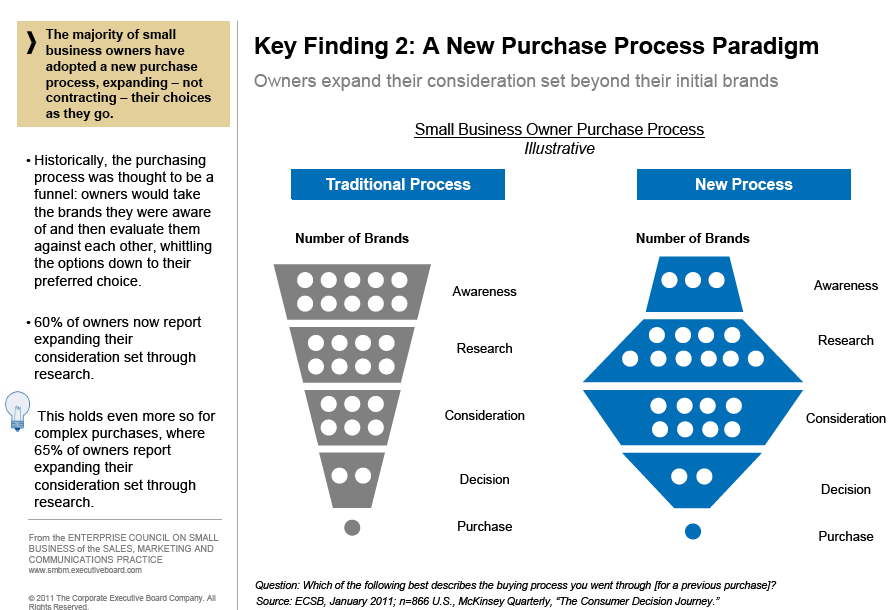
7. They Love to Search – Business owners purchase patterns have changed, instead of contracting it’s now expanding. Rather than narrowing their list of vendors, 60% of owners now report expanding their consideration set through research.
8. And it’s Local – business owners search for a product or services by name, not a brand, and they include their local area (e.g. “internet providers in St Louis”). They don’t include “small business.”
9. Search is Important, but Social Isn’t – as you saw in the previous examples Search is critical for being considered, but interesting enough, Social Media is not. The reason – small business owners view social media as a channel to speak about their businesses, rather than hear what suppliers have to say.
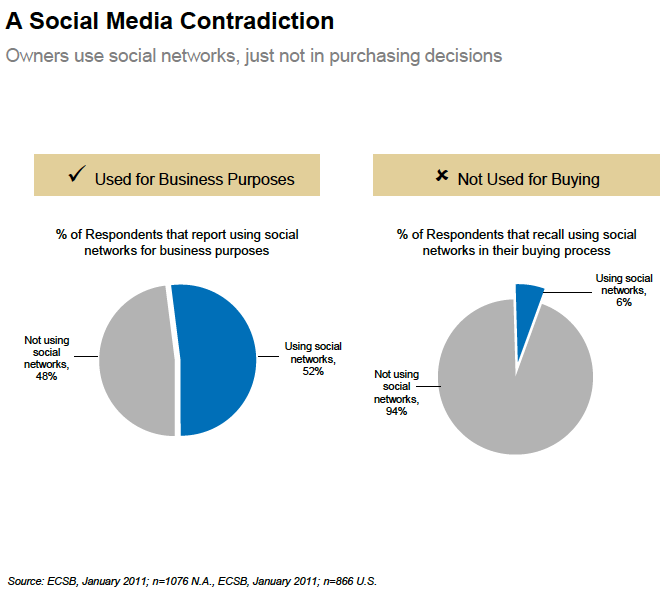
10. If You’re Not Relevant…You’re Not Relevant. In today’s marketplace to resonate with audience content must be personalized. A recent Forrester report showed that most sales forces very capable of discussing products and solution, and even the industry issues, but when it came down understanding the buyer’s role or situation they failed.
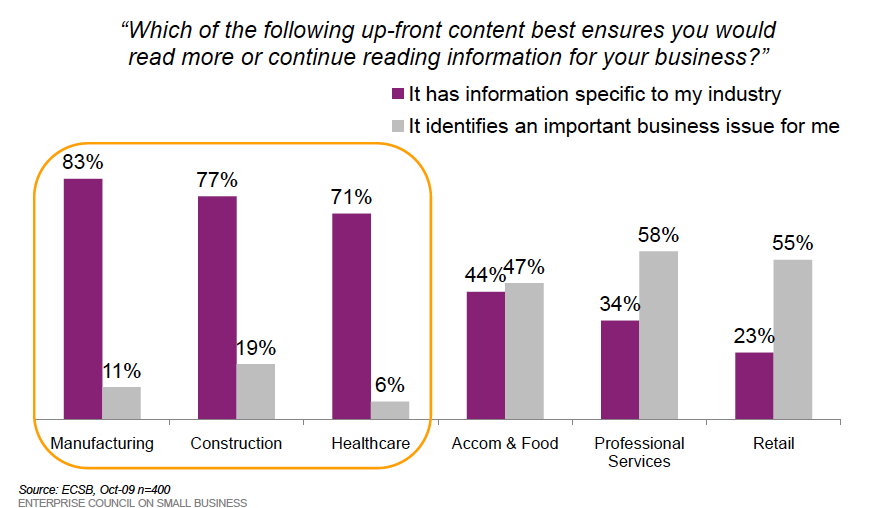
Business owners in healthcare, construction and manufacturing want information specific to their industries. Owners of professional services or retail want information specific to them.
Satisfaction owners are looking for products and services that save them time savings and strengthen their relationship with customers. With Growth Oriented owners talk ROI, and time to payback.
Summary – it’s OK to categorize your services or products as small business solutions, but don’t call the buyers small business owners. Recognize that there are two different types business owners focused on two different goals – lifestyle vs. growth. Both groups are interested in hearing your value proposition in terms of real dollars on a monthly basis, not over the year.
Business owners are heavy users of search for researching vendors, and they use social media to promote their business, but not for buying from vendors. To be relevant your content must speak to their industry or similar size businesses.
If you talk to them like you know them, show them you are committed to building a lasting relationship this dynamic market can power your organizations growth.
















